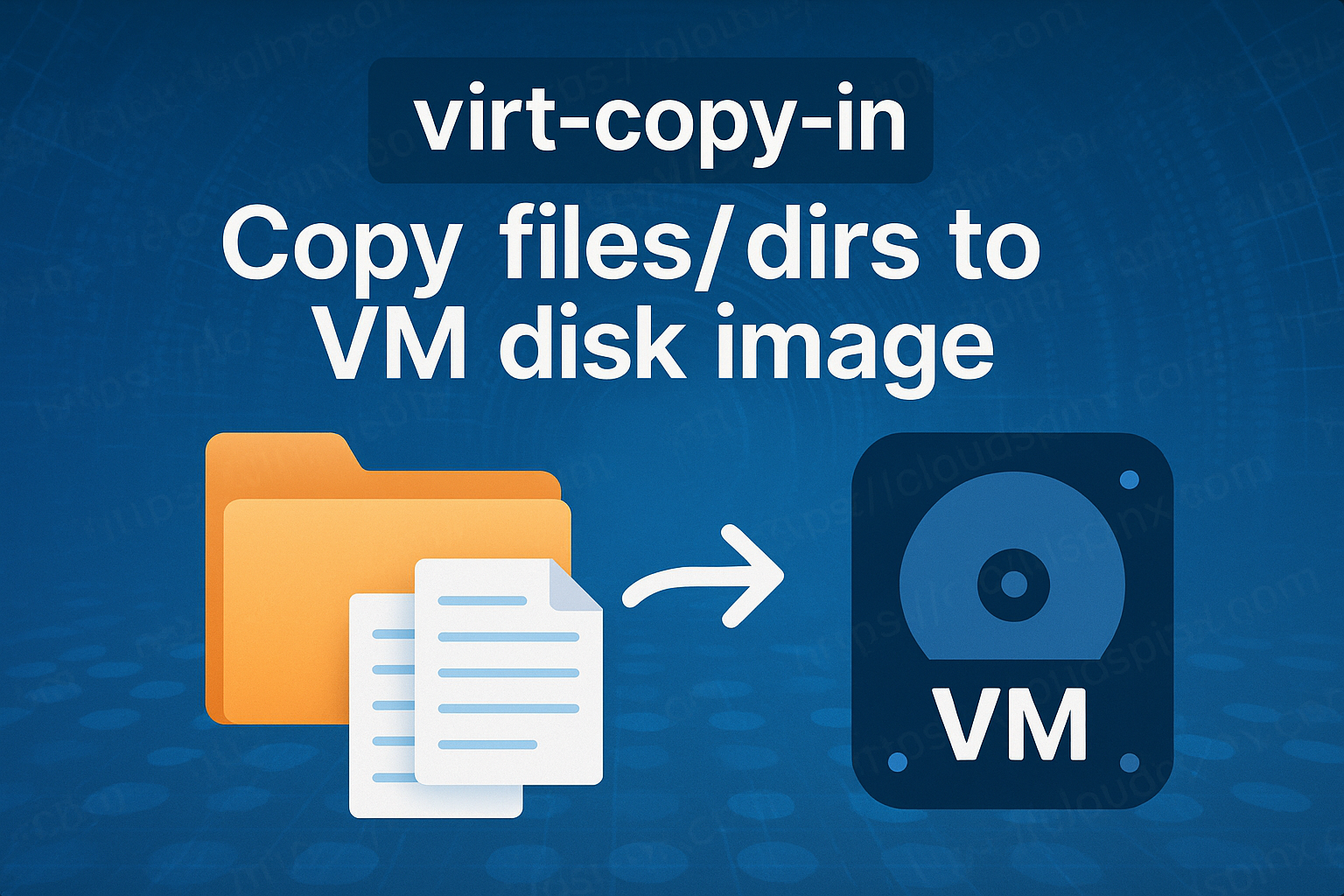When running Virtual Machines with KVM, there will likely come a time when you need to expand the size of your guest disk and possibly resize partitions as well. To meet these needs, the virt-resize tool is available. It allows you to increase or decrease the size of a virtual disk, resize partitions, and even create new disk images based on an existing one.
Mastering KVM Virtualization - The Ultimate eBook
From home labs to production clouds - master KVM Host management, automating KVM administration using Terraform, Vagrant, and cloud automation. This eBook will enable you to build scalable virtual infrastructure that works whether you're learning at home or deploying enterprise solutions. Get your full copy today
Ensure the package that provides virt-resize.
# Debian-based OS systems
sudo apt update
sudo apt install libguestfs-tools
# RHEL-based OS systems
sudo dnf install libguestfs-tools guestfs-tools
# SUSE / openSUSE
sudo zypper -n install guestfs-tools
# Arch-based Linux
sudo pacman -S libguestfs guestfs-toolsvirt-resize only works for guest virtual machines that are offline (shut down). A running guest can be powered off using the command:
virsh shutdown <vm-name>It operates by copying the guest virtual machine image, leaving the original disk image unchanged. The trade-off is that you need twice the amount of disk space.
Expanding disk image
Locate the disk image to be resized. The virsh dumpxml subcommand can be used:
virsh dumpxml <vm-name>Set guest vm disk image as variable.
DISK_IMAGE=/path/vmdisk.qcow2It’s strongly advised to back up the current disk before making any modifications to safeguard against potential issues or data loss.
# Optionally backup if you have enough storage capacity
cp $DISK_IMAGE <new-backup>.qcow2Run virt-df -h and virt-filesystems on the guest virtual machine disk to check disk size and partition layout.
sudo virt-df -h -a $DISK_IMAGE
sudo virt-filesystems --all --long -a $DISK_IMAGEExecution command output:
$ sudo virt-df -h -a $DISK_IMAGE
Filesystem Size Used Available Use%
deb12-0.qcow2:/dev/sda1 20G 1.2G 18G 7%
deb12-0.qcow2:/dev/sda15 124M 12M 112M 10%
$ sudo virt-filesystems -a $DISK_IMAGE --all --long
Name Type VFS Label MBR Size Parent
/dev/sda1 filesystem ext4 - - 20961435648 -
/dev/sda14 filesystem unknown - - 3145728 -
/dev/sda15 filesystem vfat - - 129718272 -
/dev/sda1 partition - - - 21340601856 /dev/sda
/dev/sda14 partition - - - 3145728 /dev/sda
/dev/sda15 partition - - - 130023424 /dev/sda
/dev/sda device - - - 21474836480 -In the following example we demonstrate how to resize:
- Increate the total disk size of the guest from 20GB to 40GB
- Expand the boot partition from current size to 500MB
- Expand the second partition (/) to fill the remaining space
Begin by creating a new bigger disk to match your desired size. The following command will create a 50GB disk.
qemu-img create -f qcow2 -o preallocation=metadata newdisk.qcow2 50GPerform the resizing operation from the original disk image to new disk.
sudo virt-resize \
$DISK_IMAGE newdisk.qcow2 \
--resize /dev/sda15=500M \
--expand /dev/sda1Where:
--resize <part=size>– Used to resize partition--expand <part>– Used to expand partition
Here is an output from above command execution:
**********
Summary of changes:
virt-resize: /dev/sda14: This partition will be left alone.
filesystem on /dev/sda15
virt-resize: /dev/sda15: This partition will be resized from 124.0M to
500.0M.
virt-resize: /dev/sda1: This partition will be resized from 19.9G to 49.5G.
The filesystem ext4 on /dev/sda1 will be expanded using the
‘resize2fs’ method.
**********
[ 1.5] Setting up initial partition table on newdisk.qcow2
[ 12.2] Copying /dev/sda14
[ 12.2] Copying /dev/sda15
[ 12.3] Copying /dev/sda1
100% ⟦▒▒▒▒▒▒▒▒▒▒▒▒▒▒▒▒▒▒▒▒▒▒▒▒▒▒▒▒▒▒▒▒▒▒▒▒▒▒▒▒▒▒▒▒▒▒▒▒▒▒▒▒▒▒▒▒▒▒▒▒▒▒▒▒▒▒▒▒▒▒▒▒▒▒▒▒▒▒▒▒▒▒▒▒▒▒▒▒▒▒▒▒▒▒▒▒▒▒▒▒▒▒▒⟧ 00:00
[ 21.4] Expanding /dev/sda1 (now /dev/sda3) using the ‘resize2fs’ method
virt-resize: Resize operation completed with no errors. Before deleting
the old disk, carefully check that the resized disk boots and works
correctly.Inspect the new disk image using qemu-img:
qemu-img info newdisk.qcow2We can confirm the new disk size is 50 GB:
image: newdisk.qcow2
file format: qcow2
virtual size: 50 GiB (53687091200 bytes)
disk size: 1.47 GiB
cluster_size: 65536
Format specific information:
compat: 1.1
compression type: zlib
lazy refcounts: false
refcount bits: 16
corrupt: false
extended l2: false
Child node '/file':
filename: newdisk.qcow2
protocol type: file
file length: 50 GiB (53695545344 bytes)
disk size: 1.47 GiBMove new disk to the old disk before starting the VM instance:
sudo mv newdisk.qcow2 $DISK_IMAGEWhen done start the VM
sudo virsh start <vm-name>Verify that the filesystems have grown as expected:
sudo virt-df -h -a $DISK_IMAGE
sudo virt-filesystems -a $DISK_IMAGE --all --longAlternatively, login to the VM and confirm disk partitions:
$ df -hT
Filesystem Type Size Used Avail Use% Mounted on
udev devtmpfs 1.9G 0 1.9G 0% /dev
tmpfs tmpfs 392M 540K 391M 1% /run
/dev/vda3 ext4 49G 1.2G 46G 3% /
tmpfs tmpfs 2.0G 0 2.0G 0% /dev/shm
tmpfs tmpfs 5.0M 0 5.0M 0% /run/lock
/dev/vda2 vfat 124M 12M 113M 10% /boot/efi
tmpfs tmpfs 392M 0 392M 0% /run/user/1000Expanding LVM partition
If you’re using LVM, after increasing the disk size, boot the guest VM and use the following commands to expand the LVM partition.
# List disk / partition / mount point
lsblk
df -h
# Check VG and LV
sudo vgs
sudo lvdisplay
# Extend LV fo full VG capacity
sudo lvextend -r -l +100%free /dev/<vgname>/<lvname>
# Resize LV associated filesystem
## Ext filesystems - ext4, ext3
sudo resize2fs /dev/<vgname>/<lvname>
## XFS filesystem
sudo xfs_growfs /mountpath








